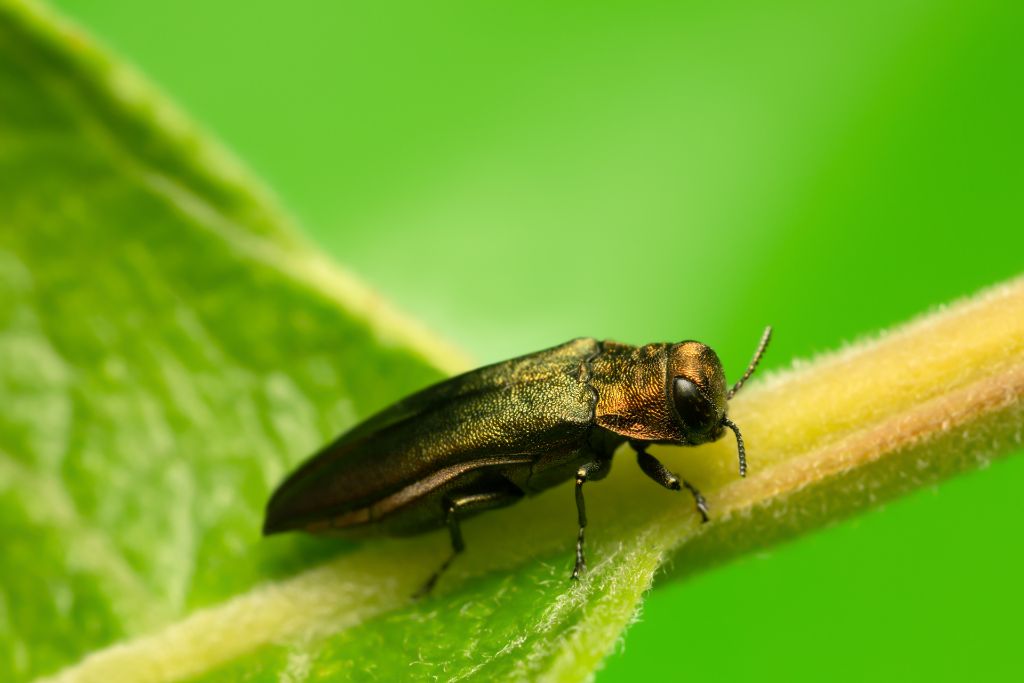Blog, Disease & Pest Prevention
Meet Agrilus Planipennis
They’re small, they’re green, and they’re from the other side of the globe. Their name is Agrilus planipennis, but they go by “Emerald Ash Borer.”
And they’re here to kill your ash trees. 
What Is The Emerald Ash Borer?
The Emerald Ash Borer is a half-inch long, green insect that somewhat resembles a grasshopper. Classified as an invasive species in the U.S., the emerald ash borer is native to eastern Russia, northern China, Japan, and Korea.
The larvae of these pests attack ash trees specifically, boring into trees below the bark and damaging the parts of the tree that move water and sugars throughout the trunk. As their name implies, these pests prefer ash trees.
How Did They Get To The U.S.?
The emerald ash borer was not identified in the U.S. until 2002 when scientists believe the species arrived on American soil accidentally in cargo delivered by ship from Asia. Once in the U.S., the pest quickly spread, mostly in the eastern part of the country. Since its first detection, emerald ash borers were soon found in Ohio, Indiana, Illinois, Maryland, Missouri, Michigan, Pennsylvania, Virginia, West Virginia, and Wisconsin.
How Deadly Are Emerald Ash Borers?
The emerald ash borer has killed millions of trees in the U.S. and in Canada. Trees typically lose their canopy within two to three years of infestation and die shortly after. It’s not uncommon for these pests to rapidly spread from tree to tree, quickly decimating large swaths of previously strong, healthy trees.
How Much Of A Threat Is The Emerald Ash Borer To Missouri Trees?
While people think often associate oaks, maples, and even dogwood trees with Missouri, the ash tree is far from rare in the state. Six species of ash tree (these include the Green, White, Blue, Pumpkin, Sullivan’s, and Biltmore ash species) are native to Missouri, and the state is home to millions of these stout hardwood trees.
As the emerald ash borer attacks all of these species – which are found in significant numbers throughout the state – the invasive insect is having a serious impact on ash trees across the state. An estimated 8 billion ash trees throughout North America are at risk from the deadly pest.
How Do They Spread?
The ash borer spreads rapidly locally by flying from tree to tree. They spread across great distances by being transported in firewood or infested wood products.
The devastating impact of the emerald ash borer is difficult to comprehend, but numbers certainly put it into perspective. Studies have found that once the emerald ash borer is transported to a new location, 99 percent of ash trees in that area are dead or dying within eight to 10 years.
How Are They Treated? Can Infested Trees Be Saved?
Treatments – several types of pesticides – for the emerald ash borer are available and have been proven to be effective. However, there are limits to the effectiveness of these treatments.
Research indicates that trees with less than 50 percent loss of their canopy have a good chance of being saved, which means early detection and aggressive treatment is key. Research has also found that preventive treatment – treating trees before infestation – is by far the most effective route to avoid the loss of trees. In addition, larger trees – even those not infested by the ash borer – can be more difficult to treat and are best cared for by professionals who have specific experience in dealing with these invasive pests.
Be Proactive And Save Your Trees
If you have ash trees, it’s important to be proactive and aggressive in fighting the emerald ash borer. Remember, as deadly and rapidly spreading as the ash borer is, it’s likely only a matter of time before your ash tree or trees are infested. Prevention is the best approach.
Our certified arborists recognize the early symptoms of infestation, and they have a wealth of experience in treating affected trees and in preventive care. Contact us today, schedule a health care appointment or a tree inspection and protect your trees!
If you are uncertain as to whether dogwoods are well-suited to your property, or if you need direction on how, where and when to plant dogwoods or other species of trees, contact us today and make an appointment with one of our certified arborists.
Contact us today!
